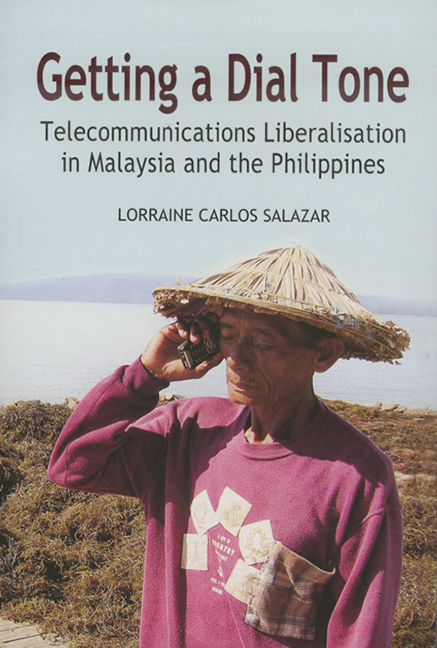Book contents
- Frontmatter
- Dedication
- Contents
- Map of Malaysia and the Philippines
- List of Tables
- List of Figures
- List of Appendices
- List of Abbreviations
- Acknowledgements
- 1 Rent-Seeking, Market Reforms, and States
- 2 Reviewing the Literature: Theories and Puzzles
- 3 Historical Overview of the State and Business in Malaysia and the Philippines
- 4 The Telecommunications Sector in Malaysia and the Philippines Before Reform
- 5 Reforming the Malaysian Telecommunications Sector
- 6 The Liberalisation of Telecommunications in Malaysia
- 7 Regulatory Reforms in Malaysia
- 8 Reforming the Telecommunications Sector of the Philippines
- 9 The New Players and the Service Area Scheme
- 10 Regulatory Reforms in the Philippines
- 11 Conclusions
- Appendices
- Bibliography
- Index
- About the Author
8 - Reforming the Telecommunications Sector of the Philippines
Published online by Cambridge University Press: 21 October 2015
- Frontmatter
- Dedication
- Contents
- Map of Malaysia and the Philippines
- List of Tables
- List of Figures
- List of Appendices
- List of Abbreviations
- Acknowledgements
- 1 Rent-Seeking, Market Reforms, and States
- 2 Reviewing the Literature: Theories and Puzzles
- 3 Historical Overview of the State and Business in Malaysia and the Philippines
- 4 The Telecommunications Sector in Malaysia and the Philippines Before Reform
- 5 Reforming the Malaysian Telecommunications Sector
- 6 The Liberalisation of Telecommunications in Malaysia
- 7 Regulatory Reforms in Malaysia
- 8 Reforming the Telecommunications Sector of the Philippines
- 9 The New Players and the Service Area Scheme
- 10 Regulatory Reforms in the Philippines
- 11 Conclusions
- Appendices
- Bibliography
- Index
- About the Author
Summary
At the end of 2005, the Philippines had 34.8 million mobile phone subscribers and 3.4 million fixed line subscribers, leading to a total teledensity of 45.1 per 100 persons. According to the National Telecommunications Commission, the industry's regulator, Filipino mobile phone users sent an average of 250 million text messages per day or an average of 6 messages per person each day in 2005.1 Because of this, the Philippines has earned the moniker “Text Capital of the World.” This situation is a far cry from the condition in 1990 when then Singapore Prime Minister Lee Kuan Yew quipped that 99 per cent of Filipinos were on queue for a phone while the remaining one per cent were waiting for a dial tone. How did this huge change come about.
This chapter examines the first stage of reforms in Philippine telecommunications. The discussion is divided into five sections. The first looks into the adoption of liberalisation as part of the government's economic reform agenda and emphasises the role of President Fidel Ramos in the process. The second focuses on how the “coalition for reform” manoeuvred to liberalise the industry and the responses of the monopolist. The third looks into the implementation of liberalisation while the fourth analyses the passage of a law ostensibly to safeguard liberalisation gains. A final section summarises the chapter's discussion and arguments.
LIBERALISATION IN THE PHILIPPINES
As Chapter 4 detailed, PLDT successfully obstructed attempts to open the telecommunications market under the Aquino administration.This chapter discusses how an historically weak and penetrated state was able to liberalise the telecommunications industry in the face of an influential vested interest. In particular, liberalisation came about through decisive executive action and support from a coalition for reform, which identified the oligarchic control of the economy as the main reason for economic underdevelopment in the Philippines. A crucial factor in the success of liberalisation was the rise to the presidency of Fidel V. Ramos, who personally sustained efforts to open the economy and made such reforms a key aspect of his administration's agenda.
- Type
- Chapter
- Information
- Getting a Dial ToneTelecommunications Liberalisation in Malaysia and the Philippines, pp. 225 - 257Publisher: ISEAS–Yusof Ishak InstitutePrint publication year: 2007

